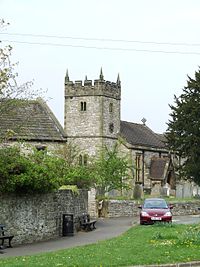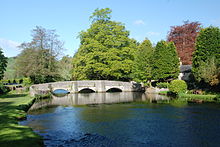Human settlement in England
| Ashford-in-the-Water | |
|---|---|
 The parish church of the Holy Trinity The parish church of the Holy Trinity | |
 | |
| Population | 559 (2011) |
| OS grid reference | SK194697 |
| District | |
| Shire county | |
| Region | |
| Country | England |
| Sovereign state | United Kingdom |
| Post town | BAKEWELL |
| Postcode district | DE45 |
| Police | Derbyshire |
| Fire | Derbyshire |
| Ambulance | East Midlands |
| UK Parliament | |
| |
Ashford-in-the-Water is a village and civil parish in the Derbyshire Peak District, England. The village is on the River Wye, 2 miles (3 km) north-west of Bakewell. It is known for the quarrying of Ashford Black Marble (a form of limestone), and for the maidens' garlands made to mark the deaths of virgins in the village until 1801. Some of these are preserved in the parish church. The civil parish population (including Sheldon) taken at the 2011 Census was 559.
History
The name Ashford derives from the Old English æsc and ford, and means a ford where ash trees grow. In 926, the village was known as Æscforda and in the Domesday Book of 1086 it was Aisseford. The addition of "in-the-Water" occurred in the late 17th century, and reflected the proximity of the village to meanders of the River Wye.
In the Domesday Book, Ashford was described as one of the locations in the area where lead was refined.
In 1786, Ashford had mills for carving and polishing the local black marble. By 1848, it had 950 inhabitants.
The village passed to the Cavendish family in the 16th century (from the Nevilles) and was finally sold off in the 1950s to pay death duties.
Culture
The tradition of well-dressing continues in Ashford as in many other villages in the Peak District. Each year slabs of clay are decorated by village volunteers using petals, leaves and other plants to create a picture. The finished designs are then displayed at the six wells around the village and the event is marked by a church service and procession through the village to bless the wells. The event takes place around Trinity Sunday.
Transport
The village is bypassed by the A6 road.
Notable buildings
Within Ashford's civil parish are 62 structures that are listed by Historic England for their historic or architectural interest. None are listed as Grade I, but there are two structures (Ashford Hall and Sheepwash Bridge) that are Grade II*. All the others, including Thornbridge Hall and the parish church, are Grade II.
Ashford Hall dates from 1785, though alterations were made in about 1840. It is a five-bay, three-storey building of gritstone and ashlar, with a balustered parapet around its slate roof. It has an early-19th-century conservatory.

The Sheepwash Bridge, which dates from the 17th century, is a packhorse bridge with an attached stone sheepwash: lambs were placed in the pen on one side of the river and the ewes swam across the river to get to them, while being pushed underwater by the shepherds to clean the fleece before shearing. Large trout inhabit the waters of the Wye around the bridge. It is a Scheduled Monument as well as a listed building.
Ashford's parish church of the Holy Trinity was mostly rebuilt in 1868–70 but has a partly 13th-century tower, a 14th-century north arcade and a recovered Norman tympanum above the south doorway. In the churchyard lies the base and stump of a Grade-II-listed churchyard cross, variously dated to the 14th or 15th century. Behind the church are traces of a moat, all that remains of a fortified house which was the home of Edmund Plantagenet, brother of Edward II.
Thornbridge Hall dates from the 18th century, but was enlarged in 1871 and radically altered in a neo-Tudor style in 1897.
Within the parish, but nearer Sheldon village, is Magpie Mine, a disused but well-preserved Derbyshire lead mine complex.
Demography
In the 2011 census, Ashford-in-the-Water was 99.5% White, and 0.2% Asian.
Notable people
Robert Armitage Sterndale, naturalist, artist, writer and statesman who worked in India before becoming Governor-general of St. Helena, was born in the village.
See also
References
- AA Book of British Villages. Drive Publications Limited. 1980. p. 32. ISBN 9780340254875.
- ^ Pevsner, Nikolaus; Williamson, Elizabeth (1978). The Buildings of England: Derbyshire. Penguin Books. p. 66. ISBN 0-14-071008-6.
- "Church history and the architecture of Holy Trinity Church, Ashford in the Water". Holy Trinity Parish Church. 13 August 2012. Archived from the original on 10 August 2016. Retrieved 12 September 2016.
- "Civil Parish population 2011". Neighbourhood Statistics. Office for National Statistics. Archived from the original on 11 October 2016. Retrieved 19 March 2016.
- Mills, David (2011). A Dictionary of British Place Names. Oxford University Press. p. 20. ISBN 978-0-19-960908-6.
- Millward, Roy; Robinson, Adrian (1975). The Peak District. The Regions of Britain. Eyre Methuen. p. 153. ISBN 0-413-31550-9.
- "Ashcombe - Ashill Pages 85-88 A Topographical Dictionary of England. Originally published by S Lewis, London, 1848". British History Online. Retrieved 14 July 2020.
- "Listed Buildings in Ashford in the Water, Derbyshire, England". britishlistedbuildings.co.uk. Retrieved 13 December 2016.
- Historic England. "Ashford Hall (Grade II*) (1109281)". National Heritage List for England. Retrieved 13 December 2016.
- Historic England. "Sheepwash Bridge (Grade II*) (1335270)". National Heritage List for England. Retrieved 12 September 2016.
- Historic England. "'Sheepwash' Bridge (1007064)". National Heritage List for England. Retrieved 12 September 2016.
- AA Book of British Villages. Drive Publications Limited. 1980. p. 32. ISBN 9780340254875.
- Historic England. "Churchyard cross (Grade II) (1109289)". National Heritage List for England. Retrieved 12 September 2016.
- Sharpe, Neville T. (2002). Crosses of the Peak District. Landmark Collectors Library. ISBN 1843060442.
- AA Book of British Villages. Drive Publications Limited. 1980. p. 32. ISBN 9780340254875.
- Historic England. "Thornbridge Hall (Grade II) (1158698)". National Heritage List for England. Retrieved 13 December 2016.
- Historic England. "Magpie, Dirty Red Soil, Maypit, Horsesteps and Great Red Soil lead mines and a limekiln, 590m south east of Johnson Lane Farm (1019490)". National Heritage List for England. Retrieved 1 February 2022.
External links
 Media related to Ashford in the Water at Wikimedia Commons
Media related to Ashford in the Water at Wikimedia Commons- Ashford-in-the-Water Parish Council
- Ashford in the 'Derbyshire UK' online guide
- Ashford [-in-the-Water] in the Domesday Book